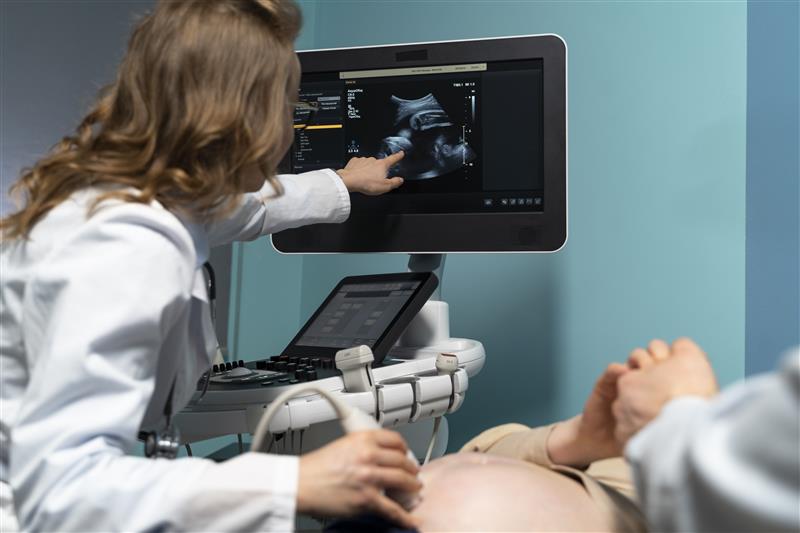At Pink Medical NY, we recognize that certain patients face an elevated risk of developing serious health conditions due to genetic predispositions, family history, or specific health factors. For these individuals, standard screening schedules and techniques may not provide adequate protection. Our surveillance ultrasound services offer an enhanced approach to early detection, providing regular, comprehensive monitoring that can identify concerning changes at their earliest, most treatable stages.
Understanding Surveillance Ultrasound
Surveillance ultrasound refers to regular, scheduled ultrasound examinations performed on asymptomatic individuals who are at increased risk for specific conditions. Unlike diagnostic ultrasound, which investigates existing symptoms or abnormalities, surveillance ultrasound is proactive—designed to detect potential problems before symptoms develop.
This approach is particularly valuable for monitoring areas of the body where early cancer detection significantly improves outcomes, such as the breast, thyroid, liver, and other organs where certain individuals have elevated risk profiles.
The Critical Importance of Early Detection
The power of surveillance ultrasound lies in its ability to identify subtle changes long before they become clinically apparent. This early detection capability offers several crucial advantages:
Improved Treatment Options
When conditions like cancer are detected at earlier stages:
- Less aggressive treatment may be sufficient
- More treatment options are typically available
- Organ-preserving approaches are often possible
- The likelihood of successful outcomes significantly increases
Reduced Treatment Intensity
Early intervention often means:
- Smaller surgical procedures with faster recovery
- Potentially avoiding chemotherapy or radiation
- Lower risk of serious complications
- Reduced treatment duration
Psychological Benefits
Regular surveillance provides:
- Peace of mind between examinations
- Reduced anxiety about undetected conditions
- A sense of proactive control over health risks
- Confidence that any issues will be caught early
Surveillance Ultrasound for Breast Health
One of the most important applications of surveillance ultrasound is in breast health monitoring, particularly for women with dense breast tissue or genetic risk factors.
The Challenge of Dense Breast Tissue
Dense breast tissue presents a significant challenge for conventional mammography, as it can mask potential cancers. Women with dense breast tissue also face an increased risk of developing breast cancer. Surveillance ultrasound provides an effective solution to this challenge.
Benefits for High-Risk Breast Patients
Surveillance breast ultrasound offers several specific advantages:
- Improved Cancer Detection in Dense Tissue: Screening ultrasound can identify additional cancers not detected on screening mammography in women with dense breasts. Studies show that if 1,000 individuals with dense breasts have a screening ultrasound after a “normal” mammogram, the ultrasound exam will identify cancer in 2 to 3 individuals.
- Earlier Stage Detection: Most cancers found exclusively on ultrasound tend to be invasive but caught at early stages when they are still contained within the breast and highly treatable.
- Complementary Approach: Combining mammography with ultrasound significantly increases detection sensitivity. In one study of high-risk women, the combination increased sensitivity from 40% with mammography alone to 81% with both modalities.
- Reduced Interval Cancers: Regular surveillance ultrasound helps identify cancers that might otherwise be discovered as interval cancers (those found between scheduled screenings).
- No Radiation Exposure: Unlike mammography, ultrasound does not use ionizing radiation, making it safe for frequent monitoring.
Who Should Consider Breast Surveillance Ultrasound?
At Pink Medical NY, we recommend breast surveillance ultrasound for:
- Women with Dense Breast Tissue: Dense tissue both increases cancer risk and makes mammographic detection more difficult.
- BRCA1 or BRCA2 Mutation Carriers: These genetic mutations significantly increase breast cancer risk.
- Strong Family History: Women with first-degree relatives diagnosed with breast cancer, particularly at young ages.
- Personal History of Breast Cancer: Survivors who need vigilant monitoring for recurrence.
- Previous Atypical Breast Biopsies: Findings such as atypical ductal hyperplasia or lobular carcinoma in situ.
- Other High-Risk Genetic Mutations: Carriers of mutations in genes like PALB2, ATM, CHEK2, or other cancer-predisposition genes.
- History of Chest Radiation: Individuals who received radiation therapy to the chest area, particularly at young ages.
Thyroid Surveillance Ultrasound
The thyroid gland is another area where ultrasound surveillance offers significant benefits for high-risk individuals.
High-Risk Thyroid Populations
Surveillance thyroid ultrasound is particularly valuable for:
- Family History of Thyroid Cancer: Individuals with first-degree relatives who have had thyroid cancer.
- Genetic Syndromes: Conditions such as Multiple Endocrine Neoplasia (MEN) type 2, Familial Medullary Thyroid Carcinoma, PTEN Hamartoma Tumor Syndrome, or Familial Adenomatous Polyposis.
- History of Radiation Exposure: Especially to the head and neck area during childhood.
- Known Thyroid Nodules: Regular monitoring of existing nodules for changes in size or characteristics.
Benefits of Thyroid Surveillance
Regular thyroid ultrasound for at-risk individuals provides:
- Early Detection of Nodules: Identifying thyroid nodules when they are still very small.
- Precise Characterization: Assessing nodule features that may suggest malignancy.
- Monitoring Growth Patterns: Tracking changes in existing nodules over time.
- Guidance for Fine Needle Aspiration: When biopsy is necessary, ultrasound ensures accurate sampling.
Retroperitoneal Surveillance Ultrasound
For certain high-risk individuals, surveillance of the retroperitoneal space—the area behind the abdominal cavity—can be lifesaving.
High-Risk Populations for Retroperitoneal Surveillance
This specialized monitoring is particularly important for:
- Lynch Syndrome Carriers: Individuals with this hereditary condition have increased risk for various cancers, including some that can manifest in the retroperitoneum.
- BRCA1/2 Mutation Carriers: These mutations increase ovarian cancer risk, which can present with subtle retroperitoneal findings.
- Family History of Peritoneal Cancer: Individuals with first-degree relatives affected by peritoneal malignancies.
- History of Abdominal or Pelvic Cancer: Survivors who need monitoring for recurrence.
Benefits of Retroperitoneal Surveillance
Regular retroperitoneal ultrasound offers:
- Early Detection of Ascites: Identifying abnormal fluid accumulation that may be the first sign of peritoneal malignancy.
- Visualization of Lymphadenopathy: Detecting enlarged lymph nodes that may indicate disease spread.
- Assessment of Organ Involvement: Monitoring organs like the pancreas that may be affected by retroperitoneal disorders.
- Detection of Ovarian Abnormalities: Identifying changes in ovarian appearance or size that warrant further investigation.
Abdominal Surveillance Ultrasound
Certain genetic conditions significantly increase the risk of abdominal organ cancers, making surveillance ultrasound an important monitoring tool.
High-Risk Populations for Abdominal Surveillance
Individuals who particularly benefit from regular abdominal ultrasound include:
- Hemochromatosis Carriers: This genetic condition increases the risk of liver cancer.
- Lynch Syndrome: Associated with increased risk of colorectal, pancreatic, and other gastrointestinal cancers.
- Familial Adenomatous Polyposis: Significantly increases risk of colorectal cancer and other gastrointestinal malignancies.
- Alpha-1 Antitrypsin Deficiency: Associated with increased liver cancer risk.
- Chronic Hepatitis B or C: Long-term viral infection increases liver cancer risk.
- BRCA1/2 Mutations: These also increase pancreatic cancer risk.
Benefits of Abdominal Surveillance
Regular abdominal ultrasound monitoring provides:
- Liver Lesion Detection: Identifying small liver lesions before they become symptomatic.
- Pancreatic Assessment: Examining the pancreas for early signs of disease.
- Gallbladder Evaluation: Monitoring for polyps or other abnormalities.
- Kidney Surveillance: Assessing the kidneys for cysts or solid masses.
The Pink Medical NY Surveillance Approach
Our approach to surveillance ultrasound is comprehensive and personalized:
Individualized Surveillance Plans
We develop customized surveillance schedules based on:
- Specific genetic mutations or risk factors
- Family history patterns
- Personal medical history
- Prior imaging findings
- Current health status
Comprehensive Documentation
Each surveillance examination is meticulously documented:
- Detailed measurements of all findings
- Comparative analysis to previous examinations
- Clear identification of any changes
- High-resolution images for future reference
Integrated Risk Management
Our surveillance program is part of a broader risk management approach:
- Coordination with genetic counseling services
- Integration with other screening modalities
- Communication with specialists as needed
- Regular risk reassessment and plan adjustment
Expert Interpretation
All of our surveillance ultrasounds are interpreted by specialists who:
- Have extensive experience with high-risk patients
- Understand the subtle findings of early disease
- Maintain awareness of the latest research
- Take a patient-centered approach to recommendations
Living with Elevated Risk: The Role of Surveillance
For individuals living with known genetic mutations or other high-risk factors, the uncertainty can be challenging. Surveillance ultrasound provides a powerful tool for managing this uncertainty.
Beyond Medical Benefits: Psychological Wellbeing
Regular surveillance provides more than just medical advantages—it offers peace of mind. Knowing that a comprehensive monitoring plan is in place allows many high-risk individuals to:
- Focus on enjoying life rather than worrying about undetected conditions
- Make confident decisions about family planning and other life choices
- Feel empowered rather than victimized by their genetic predisposition
- Build trust in their healthcare team and the monitoring process
Partnering for Health
At Pink Medical NY, we view surveillance ultrasound as a partnership between our team and our patients. We provide:
- Education about specific risk factors and what to expect
- Clear communication about findings
- Support in making informed decisions
- Coordination with other specialists as needed
- A compassionate approach that recognizes the emotional aspects of living with elevated risk
Schedule Your Surveillance Ultrasound
If you have genetic mutations, family history, or other risk factors that place you at elevated risk for specific conditions, contact Pink Medical NY to discuss our surveillance ultrasound services. Our expert team will help determine the appropriate surveillance protocol for your unique situation.
Proactive monitoring offers the best opportunity for early intervention should a problem develop. With Pink Medical NY’s comprehensive surveillance ultrasound program, you can face the future with confidence, knowing that your health is being closely monitored with the most advanced, non-invasive technology available.
This information is provided for educational purposes only and is not intended to replace the advice of your doctor or healthcare provider. Please consult with your healthcare provider regarding specific medical conditions and treatments.





